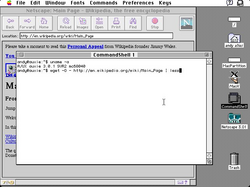Types

Operating system command-line interfacesedit
Operating system (OS) command-line interfaces are usually distinct programs supplied with the operating system. A program that implements such a text interface is often called a command-line interpreter, command processor or shell.
Examples of command-line interpreters include DEC's DIGITAL Command Language (DCL) in OpenVMS and RSX-11, the various Unix shells (sh, ksh, csh, tcsh, zsh, bash, etc.), CP/M's CCP, DOS' COMMAND.COM, as well as the OS/2 and the Windows CMD.EXE programs, the latter groups being based heavily on DEC's RSX-11 and RSTS CLIs. Under most operating systems, it is possible to replace the default shell program with alternatives; examples include 4DOS for DOS, 4OS2 for OS/2, and 4NT / Take Command for Windows.
Although the term 'shell' is often used to describe a command-line interpreter, strictly speaking, a 'shell' can be any program that constitutes the user-interface, including fully graphically oriented ones. For example, the default Windows GUI is a shell program named EXPLORER.EXE, as defined in the SHELL=EXPLORER.EXE line in the WIN.INI configuration file. These programs are shells, but not CLIs.
Application command-line interfacesedit
Application programs (as opposed to operating systems) may also have command-line interfaces.
An application program may support none, any, or all of these three major types of command-line interface mechanisms:
- Parameters: Most operating systems support a means to pass additional information to a program when it is launched. When a program is launched from an OS command-line shell, additional text provided along with the program name is passed to the launched program.
- Interactive command-line sessions: After launch, a program may provide an operator with an independent means to enter commands in the form of text.
- Inter-process communication: Most operating systems support means of inter-process communication (for example, standard streams or named pipes). Command lines from client processes may be redirected to a CLI program by one of these methods.
Some applications support only a CLI, presenting a CLI prompt to the user and acting upon command lines as they are entered. Other programs support both a CLI and a GUI. In some cases, a GUI is simply a wrapper around a separate CLI executable file. In other cases, a program may provide a CLI as an optional alternative to its GUI. CLIs and GUIs often support different functionality. For example, all features of MATLAB, a numerical analysis computer program, are available via the CLI, whereas the MATLAB GUI exposes only a subset of features.
The early Sierra games, such as the first three King's Quest games (1984–1986), used commands from an internal command line to move the character around in the graphic window.
Comments
Post a Comment